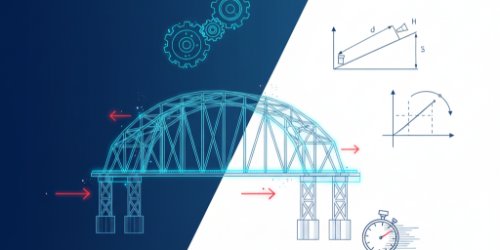Centroids and Centres of Gravity - Engineering Mechanics (Undergraduate Advanced)
15
 MEE 205: Engineering Mechanics - StaticsMaster the science of structural stability. This programme provides a complete education in engineering statics, covering the analysis of forces, moments, and equilibrium in rigid bodies. It delivers the non-negotiable principles required to design safe and reliable structures.
This learning track is for first or second-year undergraduate students in Civil, Mechanical, Aerospace, and Structural Engineering. It is the foundational mechanics course upon which all subsequent design and analysis subjects are built.
Analyse the forces within any static structure, from simple trusses to complex machines. You will master free-body diagrams, equilibrium equations, and structural analysis methods. This programme equips you with the core analytical skills for a career in structural, mechanical, or civil design.
MEE 205: Engineering Mechanics - StaticsMaster the science of structural stability. This programme provides a complete education in engineering statics, covering the analysis of forces, moments, and equilibrium in rigid bodies. It delivers the non-negotiable principles required to design safe and reliable structures.
This learning track is for first or second-year undergraduate students in Civil, Mechanical, Aerospace, and Structural Engineering. It is the foundational mechanics course upon which all subsequent design and analysis subjects are built.
Analyse the forces within any static structure, from simple trusses to complex machines. You will master free-body diagrams, equilibrium equations, and structural analysis methods. This programme equips you with the core analytical skills for a career in structural, mechanical, or civil design.
Master the science of structural stability. This programme provides a complete education in engineering statics, covering the analysis of forces, moments, and equilibrium in rigid bodies. It delivers the non-negotiable principles required to design safe and reliable structures. This learning track is for first or second-year undergraduate students in Civil, Mechanical, Aerospace, and Structural Engineering. It is the foundational mechanics course upon which all subsequent design and analysis subjects are built. Analyse the forces within any static structure, from simple trusses to complex machines. You will master free-body diagrams, equilibrium equations, and structural analysis methods. This programme equips you with the core analytical skills for a career in structural, mechanical, or civil design.
 GET 207: Applied MechanicsMaster the non-negotiable principles of Engineering Mechanics. This track delivers a rigorous, complete programme in statics and dynamics, built to the NUC GET 207 core curriculum. It moves methodically from force systems and equilibrium to the kinematics of rigid bodies and the kinetics of particles. This is the foundation of all structural and mechanical analysis.
This programme is for first and second-year undergraduate engineering students. It is an essential requirement for students in Mechanical, Civil, Structural, Aerospace, and Mechatronics engineering. A working knowledge of introductory physics and calculus is assumed.
On completion, you will be able to analyse and solve complex problems in statics and particle dynamics. You will draw free-body diagrams, apply equilibrium equations, analyse trusses and frames, and solve motion problems using Newton's laws, work-energy, and momentum methods. This programme prepares you for advanced courses, particularly Mechanics of Materials, and future professional engineering practice.
GET 207: Applied MechanicsMaster the non-negotiable principles of Engineering Mechanics. This track delivers a rigorous, complete programme in statics and dynamics, built to the NUC GET 207 core curriculum. It moves methodically from force systems and equilibrium to the kinematics of rigid bodies and the kinetics of particles. This is the foundation of all structural and mechanical analysis.
This programme is for first and second-year undergraduate engineering students. It is an essential requirement for students in Mechanical, Civil, Structural, Aerospace, and Mechatronics engineering. A working knowledge of introductory physics and calculus is assumed.
On completion, you will be able to analyse and solve complex problems in statics and particle dynamics. You will draw free-body diagrams, apply equilibrium equations, analyse trusses and frames, and solve motion problems using Newton's laws, work-energy, and momentum methods. This programme prepares you for advanced courses, particularly Mechanics of Materials, and future professional engineering practice.
Master the non-negotiable principles of Engineering Mechanics. This track delivers a rigorous, complete programme in statics and dynamics, built to the NUC GET 207 core curriculum. It moves methodically from force systems and equilibrium to the kinematics of rigid bodies and the kinetics of particles. This is the foundation of all structural and mechanical analysis. This programme is for first and second-year undergraduate engineering students. It is an essential requirement for students in Mechanical, Civil, Structural, Aerospace, and Mechatronics engineering. A working knowledge of introductory physics and calculus is assumed. On completion, you will be able to analyse and solve complex problems in statics and particle dynamics. You will draw free-body diagrams, apply equilibrium equations, analyse trusses and frames, and solve motion problems using Newton's laws, work-energy, and momentum methods. This programme prepares you for advanced courses, particularly Mechanics of Materials, and future professional engineering practice.
Course Chapters
1. Introduction3
Welcome to the course and definition of terms - centroid, centre of gravity, etc., and their uses.
Chapter lessons
2. Centroids of Areas1
Analysis of the centre of gravity (centroid of area) of flat homogenous plates with uniform thickness using those of component areas.
Chapter lessons
3. Centroids of Lines1
Analysis of the centre of gravity (centroid of area) of homogenous wires with uniform cross section using those of component lines.
Chapter lessons
4. Centroids by Integrations1
Analysis of centroids of areas and lines by direct integration.
Chapter lessons
5. Theorems of Pappus-Guldinus2
Analysis of centroids of uniform plates and wires using the theorems of Pappus-Guldinus.
Chapter lessons
6. Some Applications
Analysis of distributed loads on beams and forces on submerged surfaces using the techniques of centroids of areas and lines.
No lesson yet.
7. Centroids of Volumes (1)
Analysis of the centroids of volumes using those of component volumes.
No lesson yet.
8. Centroids of Volumes (2)
Analysis of the centroids of volumes by direct integration.
No lesson yet.